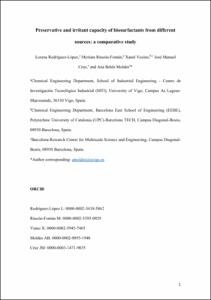Mostra el registre d'ítem simple
Preservative and irritant capacity of biosurfactants from different sources: a comparative study
| dc.contributor.author | Rodríguez López, Lorena |
| dc.contributor.author | Rincón Fontán, Myriam |
| dc.contributor.author | Vecino Bello, Xanel |
| dc.contributor.author | Cruz Freire, José Manuel |
| dc.contributor.author | Moldes Menduíña, Ana Belén |
| dc.contributor.other | Universitat Politècnica de Catalunya. Departament d'Enginyeria Química |
| dc.date.accessioned | 2019-11-15T19:01:08Z |
| dc.date.available | 2020-07-30T00:28:08Z |
| dc.date.issued | 2019-07-01 |
| dc.identifier.citation | Rodríguez, L. [et al.]. Preservative and irritant capacity of biosurfactants from different sources: a comparative study. "Journal of pharmaceutical sciences", 1 Juliol 2019, vol. 108, núm. 7, p. 2296-2304. |
| dc.identifier.issn | 1520-6017 |
| dc.identifier.uri | http://hdl.handle.net/2117/172592 |
| dc.description.abstract | One of the most important challenges for pharmaceutical and cosmetic industries is solubilization and preservation of their active ingredients. Therefore, most of these formulations contain irritant chemical additives to improve their shelf-life and the solubility of hydrophobic ingredients. An interesting alternative to chemical surfactants and preservatives is the use of biosurfactants; thus, their surfactant properties and composition make them more biocompatible than their chemical counterparts. Moreover, some biosurfactants have shown antimicrobial activity in addition to their detergent capacity. In this work, the antimicrobial and irritant effect of 2 biosurfactant extracts was studied: one produced in a controlled fermentation process with Lactobacillus pentosus and the other produced from corn stream by spontaneous fermentation. The results showed a strong antimicrobial activity of the biosurfactant extract obtained from corn stream on pathogenic bacteria, in comparison with the L. pentosus biosurfactant extract. Moreover, both biosurfactants did not produce any irritant effect on the chorioallantoic membrane of hen's egg assay contrary to sodium dodecyl sulfate. This is the first study dealing with the application of biosurfactant extracts on sensitive biological membranes, and this is the first time that the preservative capacity of a biosurfactant extract obtained in spontaneous fermentation is being evaluated, achieving promising results. |
| dc.format.extent | 9 p. |
| dc.language.iso | eng |
| dc.publisher | Wiley |
| dc.subject | Àrees temàtiques de la UPC::Enginyeria química |
| dc.subject.lcsh | Biosurfactants |
| dc.subject.lcsh | Corn |
| dc.subject.lcsh | Pharmaceutical industry |
| dc.subject.other | Biosurfactant |
| dc.subject.other | Preservative |
| dc.subject.other | Nonirritant |
| dc.subject.other | Corn |
| dc.subject.other | Lactobacillus pentosus |
| dc.subject.other | Escherichia coli |
| dc.subject.other | Candida albicans |
| dc.subject.other | Aspergillus brasiliensis |
| dc.title | Preservative and irritant capacity of biosurfactants from different sources: a comparative study |
| dc.type | Article |
| dc.subject.lemac | Biosurfactants |
| dc.subject.lemac | Blat de moro |
| dc.subject.lemac | Industria farmaceútica |
| dc.contributor.group | Universitat Politècnica de Catalunya. R2EM - Resource Recovery and Environmental Management |
| dc.identifier.doi | 10.1016/j.xphs.2019.02.010 |
| dc.relation.publisherversion | https://www.sciencedirect.com/science/article/pii/S0022354919300954 |
| dc.rights.access | Open Access |
| local.identifier.drac | 24017371 |
| dc.description.version | Postprint (author's final draft) |
| local.citation.author | Rodríguez, L.; Rincón, M.; Vecino, X.; Cruz, J.; Moldes, A. |
| local.citation.publicationName | Journal of pharmaceutical sciences |
| local.citation.volume | 108 |
| local.citation.number | 7 |
| local.citation.startingPage | 2296 |
| local.citation.endingPage | 2304 |
Fitxers d'aquest items
Aquest ítem apareix a les col·leccions següents
-
Articles de revista [210]
-
Articles de revista [2.226]


